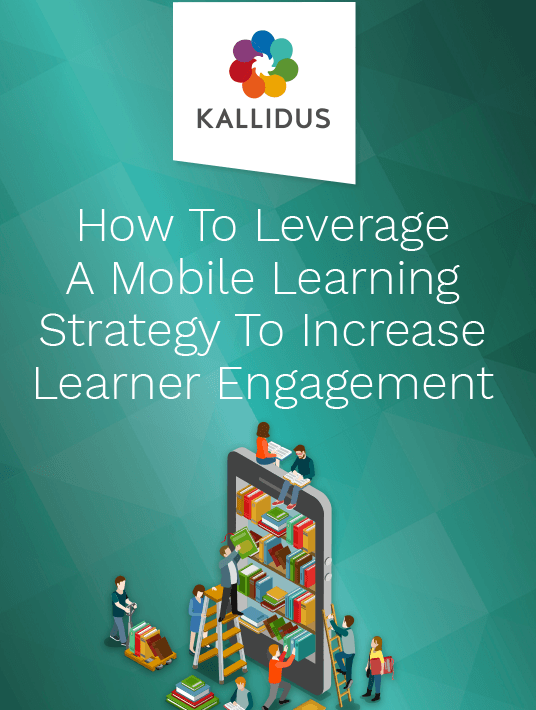What The Elements Of A Successful Mobile Learning Strategy Are
When developing a mobile learning strategy, it can be easy to get carried away with the shiny new elements of the latest learning technology. However, it is important to remain grounded in organisational aims and the bigger picture. Investing in a mobile learning strategy can mean a big change in the way your organisation manages learning so it’s important to go in with your eyes open, fully prepared to present to those who make the final decisions. It’s also important to invest time in finding out how your workforce feel about the changes, and how comfortable they are with using mobile devices for their eLearning (or in this case, mLearning). This research will help you to formulate a strategy that works for everyone and one that you know your learners will engage with. Once it’s time to put your mobile strategy together, these are the essential elements you need to include.

1. Mobile Learning Objectives
Any strong strategy starts with KPI-based objectives. While individual objectives will come later down the line, for now, we’re looking at how these work at an organisational level. Introducing mobile learning into your strategy can create huge shifts in things like workplace learning culture, self-directed learning, and continuous self-development. Ultimately, in order to measure the level of success of your strategy and prove it’s worth to the key decision makers in your organisation, you need something to measure. Your key mobile learning objectives are the best way to do this and allow for transparency as well as something clear to aim for.
2. Bring Your Own Device (BYOD) Or Provided Devices?
One of the big questions you will need to ask yourselves before you invest in content or hit the ground running with LMS development is whether you would like for your learners to use their own mobile devices for training. Success has been found on both sides of this debate but there are a number of pros and cons on each side. For example, BYOD can help you to cut down on hardware costs as your learners will use devices they already own to complete their training. However, supplying devices can cut down costs for ongoing development in the long run. Ultimately, you need to figure out if BYOD is the right strategy for your organisation and allow your decision here to influence a large part of your ongoing mobile learning strategy.
3. Microlearning On Mobile Devices
We can’t talk about mobile learning without discussing microlearning. Breaking training down into bite-sized chunks, microlearning is the perfect eLearning solution for mobile. Ranging typically from 1–10 minutes long, each of these modules, lessons, or courses are optimised for mobile devices and can contain any kind of eLearning content from simulations and videos to documents and animations. Proven to increase engagement, with or without mobile devices involved, microlearning allows your learners to tick off more items on their training to-do lists, helping them to stay motivated to learn. Microlearning comes in many forms, from simulations and videos to animations and quizzes, all wrapped up in small chunks to keep your employees engaged and actively participating in their learning.
4. Consider Your Field-Based And Remote Workers
One of the biggest benefits of mobile learning is that it allows a consistent and flexible learning experience for all of your employees regardless of their location. One of the big things to consider for those embarking on training on-the-go is that low-data alternatives to your go-to training may be required. While microlearning will help this, by ensuring long pieces of media-rich content are broken up into smaller pieces, there are still some things to ensure a poor internet connection isn’t going to get in the way of important training. For example, you can provide transcripts underneath videos within your LMS in case video content doesn’t load. Alternatively, you can look at the data consumption of different types of content; animations, for example, require less bandwidth than high-res video. While the hope will be that your learners (especially if using their own devices) won’t have to eat into their data, you need to be prepared for slow WiFi connections as well.
5. Encourage Collaboration Through Channels Your Learners Already Use
Collaborative learning is a huge talking point in the world of L&D for 2019. With proof of increasing engagement as well as promoting knowledge-sharing, collaborative learning is a hidden cost-free tool within your organisation’s arsenal. Your mobile learning strategy is the perfect place to tap into it. Although most of your workplace learning will take place on an LMS, it’s not the be all and end all of a mobile learning strategy. It shouldn’t be a case of if collaborative learning comes into it, but more a case of when and how. In particular, you assess which channels to use. Within every organisation there will be group chats on Slack or WhatsApp or Microsoft Teams or Skype about anything from fantasy football to organising dinner parties. Make the most of the platforms your learners are already using to collaborate on—follow the bright spots—and allow your mobile learning strategy to journey beyond the realms of the LMS.
6. KPIs And Measuring Success
One of the most important factors of any strategy is how you are going to measure its success. We’re not here to tell you the KPIs you should be setting, only that they should cover the needs of your organisation and focus on three things: the input from your L&D team(s), the output from your learners, and the outcome for your organisation. Think of these as large-scale objectives, measurable with data through the reporting in your LMS. Everything from engagement levels to sales figures can be impacted by a shift in learning strategy. With enough planning and time invested in pulling your mobile learning strategy together, you’d be amazed at the things that can be achieved on an organisational level from changing how your employees learn.
Conclusion
So, there you have it. 6 key components and considerations of any successful mobile learning strategy. From mobile-friendly content to the bigger changes you wish to see as an organisation, you’re now ready to research and shape your own strategy and welcome mobile into your organisation’s learning practices. Feel like delving into a next level mobile learner strategy? Download the eBook How To Leverage A Mobile Learning Strategy To Increase Learner Engagement to learn how collaboration, microlearning, strategy development and a transformation to mobile learning can enable you to really boost engagement.

